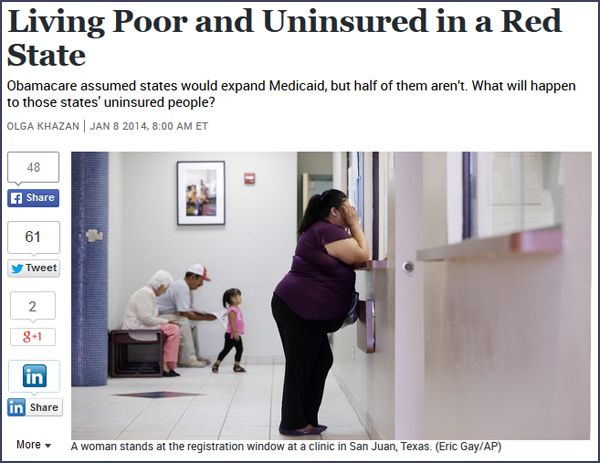So, there's a really important article in The Atlantic today about poverty and healthcare in the US: "Living Poor and Uninsured in a Red State: Obamacare assumed states would expand Medicaid, but half of them aren't. What will happen to those states' uninsured people?"
I am recommending the article, because it's very good. But I have questions about the photo that was chosen for the top of the article.

All of the other photos in the piece were taken by the writer, but the one at the top, the first thing people see, is an AP photo of an unnamed fat woman with her face covered with her hand. Which doesn't make her a headless fatty, but a faceless one.
Now, certainly, there is an anonymity issue to consider when publishing an image of a person accessing healthcare. But are The Atlantic's editors really unaware of the issues surrounding publishing images of fat people whose faces and/or heads are not visible?
Further, are they really unaware of the narratives around fat people and healthcare? And fat people and poverty? And the potential for this particular image to flavor the entire article in a very specific way for the many people who are inclined to believe that fat (especially fat and poor) people do not deserve access to healthcare, especially healthcare subsidized by tax dollars?
That the woman in the photo may be Latina only further complicates the issues around an article primarily about healthcare and poverty in Texas.
Were none of the people to whom the author spoke willing to have their photos taken while accessing healthcare? If not, did the woman in this image give her consent for her image to be used in a story about poverty and healthcare in Texas?
(I realize consent for the publication of wire images is not the norm. But just because something is the norm doesn't mean it's right. See: Why Progressives Exist.)
I'm not assuming bad faith. I don't imagine whoever chose to use this picture did so with any kind of malicious motives. But, as every journalist and editor knows (or should know), images of people from marginalized populations tend to turn those people into representatives of whole populations against which people with biases wield their judgments.
Using a picture of a fat woman of color in a story about healthcare and poverty has to be done sensitively. It has to center consent, so as to honor individual identity. It cannot be (even inadvertently) dehumanizing.
If you cannot find a subject who explicitly consents to participation in that way, well, maybe there's a reason for that. And maybe you just need to use another kind of picture altogether.




Shakesville is run as a safe space. First-time commenters: Please read Shakesville's Commenting Policy and Feminism 101 Section before commenting. We also do lots of in-thread moderation, so we ask that everyone read the entirety of any thread before commenting, to ensure compliance with any in-thread moderation. Thank you.
blog comments powered by Disqus